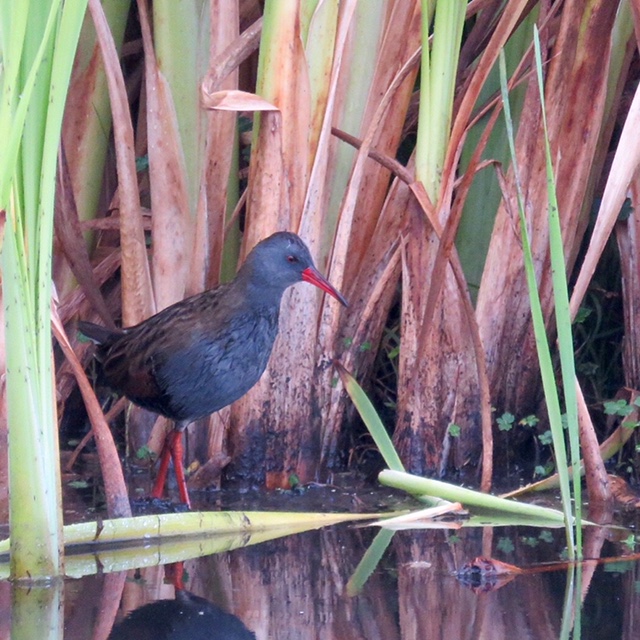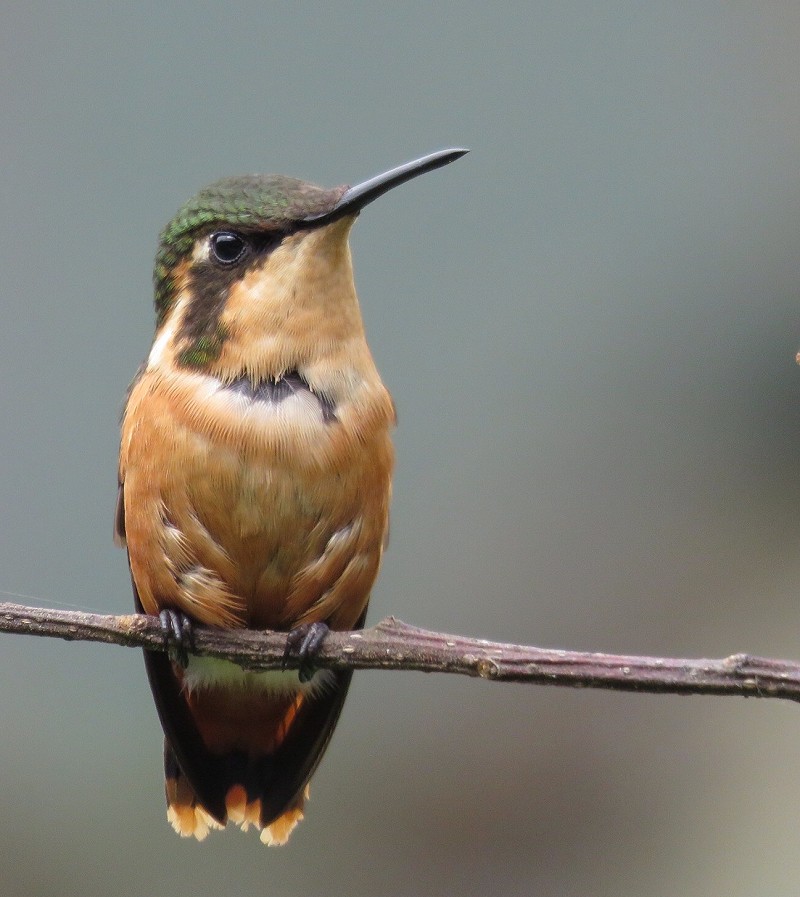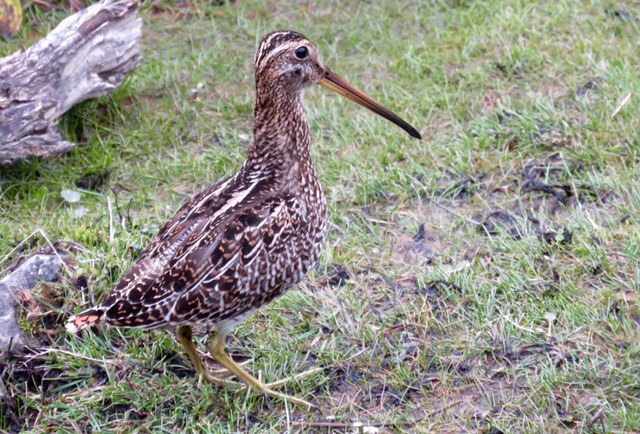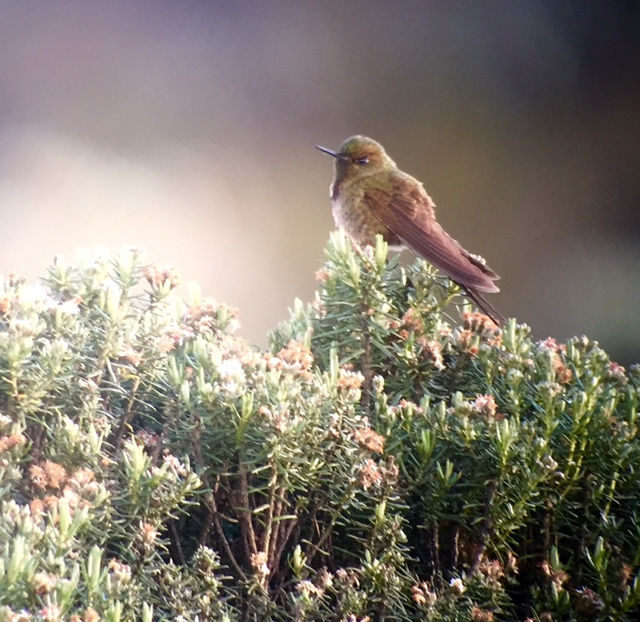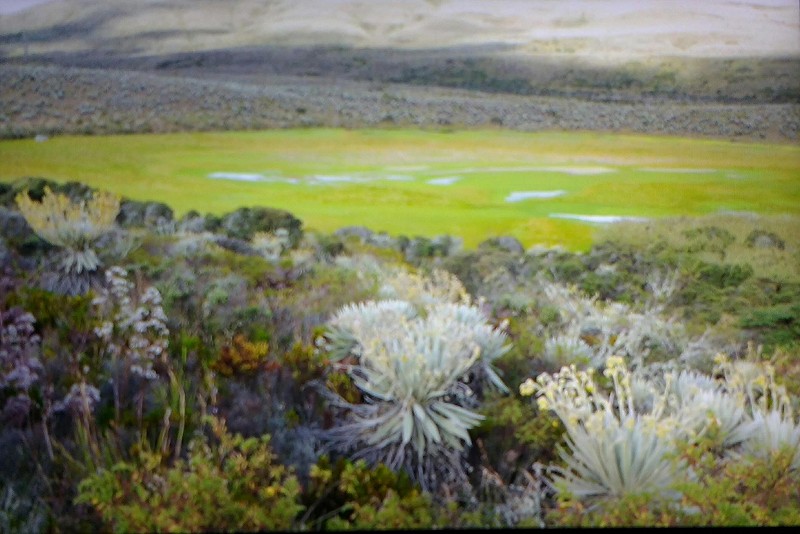October 10 - 15: Colombia (1)
20 October 2016 · Remco Hofland · 40744 × bekeken
PLEASE MAKE A DONATION NOW!
world.observation.org/arjan
www.arjandwarshuis.com/#biggestyear
This blog has been written by one of my travel companions Remco Hofland, to show you my adventure from a different perspective...
Arjan Dwarshuis
Preface
In the late evening of Oct 9 Arjan arrived at the Bogotá hotel where we (Dutch birders Gerjon Gelling, Garry Bakker and Remco Hofland) were waiting for him after three days of getting used to the time zone and altitude. There he was: slim, rough-bearded, lightly packed, with roughly 337 birds to go to break the world birding record. We exchanged news and listened to his stories about northern Ecuador, and were surprised by his enthusiasm, even after nine months, to go out birding the next morning.
October 10th: BOGOTA RAIL
The early morning of Oct 10 saw us at the Siecha marshes, where Alejandro Pinto of Colombiabirding guided us to the part of the marsh where GG, GB and I had seen Bogota Rail two days earlier. Noble Snipe, Solitary Sandpiper and Yellow-hooded Blackbird (all new) and Spot-flanked Gallinule (new taxon, with greener bill than the one seen in Argentina) were seen well, before bagging the rail with great footage to boot.
We continued towards Chingaza NP where we bumped into a bird we didn't expect to see: Coppery-bellied Puffleg (usually easy at Observatorio de Colibris, but not in the past couple of weeks). Other interesting birds included Rufous-browed Conebill, Silvery-throated Spinetail and Black-backed Grosbeak, while Red-crested Cotingas were seemingly everywhere.
The Observatorio de Colibris duly produced Blue-throated Starfrontlet (along with more Red-crested Cotingas and some spectacular Sword-billed Hummingbirds). A rainy afternoon followed, with roadside birding near Mundo Nuevo producing Ochre-breasted Brushfinch, Northern Mountain Cacique and Buff-breasted Mountain-Tanager. The feeders in Mundo Nuevo proved a great place to spend the remaining rainy hours of daylight, with Lazuline Sabrewing, Short-tailed Emerald, Green-bellied Hummingbird and Longemare's (Amethyst-throated) Sunangel as highlights. While the three of us walked the village looking for Black-and-white Owl, a bird Arjan saw several of during his Biggest Year, Arjan concentrated on writing an article (and we dipped). The pre-dinner foray long the access road was more succesful, with a beautiful male Lyre-tailed Nightjar. We had a quiet night at this charming little village, set between two green hillsides with a couple of Dutch-looking cows and stands of native forest, and the ever-present sound of the river coming from below.
October 11th: CHINGAZA NP
Fortunately, we were lucky with the weather when at 5 am we drove up into Chingaza NP in the oldest Toyota Landcruiser of Colombia over the roughest back road of Colombia (although, in fact, the country has more of both). Almost as soon as we got out of the car, on the edge of fincas and cloudforest, we saw the vulnerable Flame-winged (Brown-breasted) Parakeet, followed by great views of a pair of Black-billed Mountain-Toucan, a bird Arjan had only heard in Ecuador. We then basically walked the first 100m of the trail until we encountered good stands of Chusqea bamboo where, with perseverance, we eventually had good views of the endemic Matorral (Pale-bellied) and the odd (large & long-tailed) Ash-colored Tapaculo. At one point, an unexpected Rufous Antpitta hopped into view as well, much to our delight. Back at our b&b in Mundo Nuevo at 8 am, we were treated to a second breakfast (after the one we enjoyed at 4.40 am), as well as scopeviews of a pair of Torrent Ducks in the river below.
Thick Bogota-edge traffic aside, our 4-hr drive to Sumapaz NP was uneventful. However, our afternoon at this beautiful high-paramo park, the biggest of its kind in the world, wasn't. Our prime targets for the Biggest Year were Apolinar's Wren, easily found, and two hummingbirds: Green-bearded Helmetcrest and Bronze-tailed Thornbill. The former is a great-looking creature with a long crest and beard (relatively long that is, for a bird the size of a ping-pong-ball) - at least, I think it's great-looking because despite walking around at 3,700m altitude for five hours, I never saw one perched. And this is said to be the easiest of the two hummers! In fact, for the first couple of hours the highlights, aside from the wren, consisted of several Tawny Antpittas, cute Andean Tit-Spinetails, a Black-breasted Buzzard-Eagle and a Jameson's (Andean) Snipe feeding at close range. After having walked 3 km's up and down the road, all we had to show for hummer-wise were three distant fly-by's and a female hovering in front of a yellow flower for 3 secs (its head obscured by a flower in my case) before it disappeared over a vast expanse of 'pygmy palmtrees' (I'm no botanist, suggestions to the ID welcome).
Things improved when at 3 pm we encountered several Tawny-rumped Tyrannulets, a cute nomadic flycatcher that usually is hard to connect with. Even better were the waders found on the edge of the beautiful lakes and ponds in this extraordinary landscape. We enjoyed good views of a first-winter Wilson's Phalarope and several Greater Yellowlegs before a Calidris sandpiper flew past, which we immediately recognised as White-rumped Sandpiper. We shouted it out to Alejandro & Arjan, who stood 500m away from us, knowing it was one of the few Nearctic waders still lacking in the Biggest Year. Arjan explained he had also recognised the bird, informing Alejandro who, much to his dismay, missed it - as this was not only a rare Colombian migrant but also a lifer! While trying to relocate the sandpiper, Arjan and I saw a small hummer fly our way and moments later we were all enjoying frame-filling scopeviews of a male Bronze-tailed Thornbill perched on top of a roadside bush. Then, in the last half hour of daylight, Arjan found a small flock of Calidris, that turned out to consist of two Baird's and no less than three White-rumped Sandpipers. We took record shots and video of the distant flock; Alejandro vowed to be back later in the week to try and obtain better views and footage of his unexpected lifer. That night in our Bogota hotel, José Castaño of Colombiabirding joined the party: he'll be with us until the end of the Biggest Year' Colombia leg.
October 12th: PEDRO PALO: TURQUOISE DACNIS
In the morning of Oct 12 we were to bird Pedro Palo. Targets for The Biggest Year, Colombiabirding owner Diego Calderon had established pre-trip, were the endemic Turquoise Dacnis, along with Moustached Brushfinch & Rosy Thrush-Tanager. Other initial targets included Rusty-breasted Antpitta, a species Arjan already bagged earlier in the year, although he saw it at Manu road, southeast Peru, where another subspecies occurs that may well turn out to be a full species in the near future.
We started birding at 6 am, and soon we were cleaning out one flock after another. New Biggest Year ticks included Scrub Tanager (common) and White-throated Toucanet, lifers for all. Arjan soon found our first Turquoise Dacnis, a distant male in a fruiting tree frequented by Black-capped Tanagers. Since he has been travelling South America for the past four months, Arjan easily identified most birds on appearance and sound, incl many of the flycatchers such as Sooty-headed Tyrannulet, Slaty-capped Flycatcher & Greenish Elaenia. Then, another small flycatcher caught our eye and Arjan urged Garry to take good pictures of it. The presence of a third wingbar confirmed our suspicions: new Biggest Year tick Small-billed Elaenia! Our ID of this austral migrant was later confirmed by Dusan Brinkhuizen, the renowned Ecuador-based Dutch birder who has become a Neotropical flycatcher specialist.
The beautiful endemic hummer Black Inca was seen well, and Olivaceous Piculet, Rufous-naped Greenlet, Lineated Foliage-gleaner, Stripe-breasted Spinetail and, with more difficulty, a single Moustached Brushfinch were seen in relative quick succession. Moustached Puffbird & Rosy Thrush-Tanager however remained silent, while Rusty-breasted Antpitta was unfortunately heard only, too distant to coach the bird into showing itself. The fact that it started raining heavily at 9 am didn't help: it even rained during lunch. After lunch we said goodbye to Alejandro, and continued with José and driver Erney.
During the long afternoon drive we saw many Mississippi Kites above Girardot city, while in the scrub near Rio Coello we quickly found new birds like Velvet-fronted Euphonia, Spectacled Parrotlet, Apical Flycatcher, Ruddy-breasted Seedeater and Summer Tanager, as well as another lifer for Arjan: American Yellow Warbler. In the last light we enjoyed a perched Aplomado Falcon overseeing the attempts of a Bat Falcon hunting dragonflies. A flycatching cuckoo turned out not to be the hoped-for Dwarf, but a Yellow-billed Cuckoo instead. A long drive and a pizza later we arrived at our hotel at 9.15 pm, excited to start what feels like our fourth consecutive big day tomorrow!
October 13th: TOLIMA AND OTUN
In order to not only break the world record, but also set a new one as high as possible, Arjan is doing this Colombia trip more or less twice as fast as other birders. Therefore, we were happy to see all Tolima specialties in under two hours, when near the village of Juntas we saw Tolima Dove, Tolima Blossomcrown, Yellow-headed (Olive-headed) and Yellow-throated (White-naped) Brushfinch, along with Pale-edged Flycatcher and Bar-crested Antshrike. A huge blossoming tree opposite our breakfast café produced additional Acorn Woodpecker and Orange-crowned Oriole, before hitting the road again for the 6-hr ride to Otun. We soon found ourselves in a slow line of endless trucks, over the 'highway' between Bogotá and the main port Buenaventura. Overtaking a truck driving 10 km/hr meant finding oneself behind the next, perhaps doing 12 km/hr ...
The long drive was however the perfect opportunity to interview Arjan about his motivation to do a Big Year, as well as his high- and lowlights. More about that later.
We were told to be at the Otun-Quimbaya forest no later than 4.30 pm, to stand the best chance of seeing the localised Hooded Antpitta. Unfortunately, with 40 mins to go we drove the bad road up to the Otun-Quimbaya lodge behind a very slow truck (bringing Arjan to boiling temperature) and with only 15 mins to go found the road blocked by a Hyundai Tucson, whose (female) driver didn't dare to move (forward or backward). Our guide José took the wheel and parked the car under a waterfall, so our van could pass (while Arjan got close to exploding). This unscheduled stop did produce our first Cauca Guans though, while the drive also produced Mountain Paca and Long-tailed Weasel crossing the road.
Whatever unfortunate delays we had, at exactly 4.30 pm we arrived at the correct spot - but our effort was in vain, as it started to rain and there was no sign of the wanted antpitta. The last new birds were Swainson's Thrush and Chestnut-breasted Wren - until, at dusk, we located a calling Hooded Antpitta, which at least would give us a chance at seeing it tomorrow. Returning to the lodge, we located a Common Potoo and a calling Columbian Screech-Owl above the road, while being surrounded by hundreds of fireflies, a wonderful sight.
October 14th: HOODED ANTPITTA?
Perhaps I should tell you my most-wanted bird in South America is, and has been for many years, White-capped Tanager. Arjan only heard the bird in Ecuador, and given the fact he wants to (not only hear but also) see as many birds as possible during his Biggest Year, it is not surprising we ran back to the road when, having just settled ourselves at the Hooded Antpitta location, we heard White-capped Tanagers calling nearby. Not entirely unsurprising, we saw neither of them! Some consolation was a singing Chestnut-breasted Wren, while Arjan was extremely pleased with the feeding Moustached Antpitta on the road at first light - a bird he missed in Ecuador.
One would think that the Multicolored Tanager we found at Otun-Quimbaya would be the day's highlight, but it wasn't. We had lunch at the lodge, amidst local tourists amused by this group of tall, binoculars-wearing men, and then drove a couple of hours to a town where we exchanged our spacious van for an old Jeep, in which we drove into the mountains for over an hour. Like many other Colombian mountainous sites, we passed by many fincas and trashed habitat, until finally we reached the very last bits of cloudforest near the top of this old mountain. Our target here was the rarest bird in Colombia, and one of the rarest in the world: Fuertes's (Indigo-winged) Parrot. We positioned ourselves at a sunny slope, overlooking a small wooded valley in which, believe it or not, White-capped Tanagers were calling loudly. Fortunately I missed the birds Arjan, Gerjon and Garry saw flying past low in the valley, as obviously this is a bird one has to see perched, preferably in the scope, to fully appreciate its beauty. Soon after we enjoyed great fly-by views of several pairs of Fuertes's Parrot and Garry, king of the flightshot, managed to obtain quite good footage of them. The fading light on the forested upper slopes, with no other sound than a calling Undulated Antpitta in the nearby bamboo, was a magical ending to this day - after which we had to drive for several hours ..
October 15th: ANTPITTA BONANZA
Having arrived late at Reserva Ecologica Rio Blanco, one of the best spots in the world for the rare and localised Masked Saltator, we liked getting up 'late' this morning, 5.30 am, with birding from our veranda. Since the saltator didn't show (nor did the hoped-for White-capped Tanagers) we did a small stroll through the forested surroundings of the beautifully situated lodge before breakfast. We were joined by 4 Columbians for our steep uphill walk (Flammulated Treehunter in one of the flocks) to no less than three antpitta feeders at which we easily saw four of these fantastic creatures: Chestnut-crowned, the endemic Brown-banded, the tiny übercute Slaty-crowned and finally Bicoloured. Other birds joined in the feast, resulting in multiple close ups of worm-/grub-eating Green-and-black Fruiteaters and Grey-browed Brushfinches.
During the walk that followed, over a cloudforested ridge, I was able to obtain great footage of Arjan, Garry and Gerjon eagerly, and very concentrated, anticipating views of two Ocellated Tapaculos who were calling from the nearby undergrowth. Despite being brightly coloured, fairly big birds, it took over half an hour before anyone, including José and the local guide, glimpsed the birds for the first time. Despite all the antpittas and the tapaculo, my personal highlights for this wonderful, and again rain-free day, were great views of Chestnut Woodquail and Black-collared Jay!
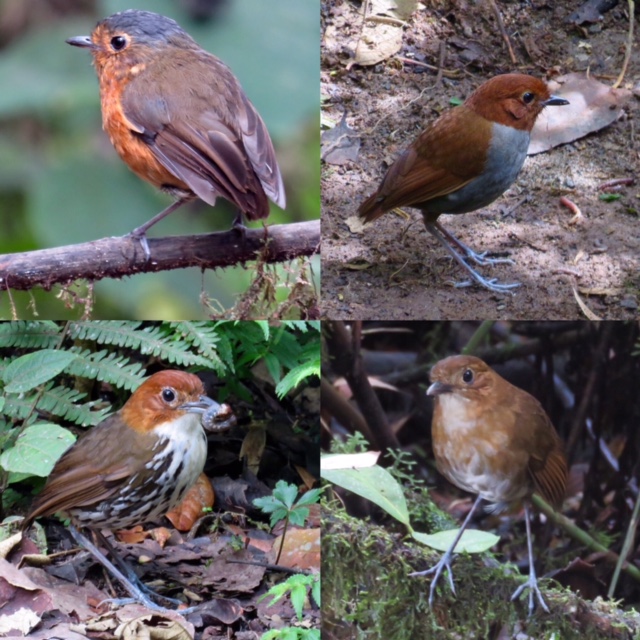 Slaty-crowned Antpitta Grallaricula nana, Bicolored Antpitta Grallaria rufocinerea, Chestnut-crowned Antpitta Grallaria ruficapilla, Brown-banded Antpitta Grallaria milleri (Arjan Dwarshuis)
Slaty-crowned Antpitta Grallaricula nana, Bicolored Antpitta Grallaria rufocinerea, Chestnut-crowned Antpitta Grallaria ruficapilla, Brown-banded Antpitta Grallaria milleri (Arjan Dwarshuis) ARJAN's DRIVE
Each and everyone of us likes birding. But having queried many birders, including top guides of well-known birdingtourcompanies, there are very few, if any, who thought they'd be able to bird for every single day in an entire year - and enjoy it.
Now, Arjan does. But that, obviously, is not the only reason he is well on his way of establishing a world record. He is extremely keen, sharp and well-prepared. Constantly reading up on available literature, he'll only count a new Biggest Year bird after being totally convinced of his (our) ID. (For example, few days ago we both saw a bird we flushed off the forest floor: clearly a quail-dove, and purplish-black. Between the two of us we must have over a year of neotropical birding experience, so the likely ID would be: Indigo-crowned Quail-dove. Not that we counted it as such.)
Arjan has another quality: he has a hard time giving up on a bird, even though available literature suggests it's rare. And, even during our (fortunately rare) rainy mornings, he presses on knowing there might be a bird, or even an entire flock of them, lurking around the next corner.
Sure he misses his girlfriend Camilla, his parents & friends. But, with current communication opportunities, he speaks to them almost daily - apart from spending about two hours a day writing blogs and articles, learning 30-40 new birdsounds, reading birding literature, arranging details on the next two birding months, oh, and birding and sleeping. If you don't mind - I thought I'd relieve him from his blogging duty for a week ...
Remco Hofland
PLEASE MAKE A DONATION NOW!
world.observation.org/arjan
www.arjandwarshuis.com/#biggestyear
Discussie
Rogier Karskens
·
20 October 2016 16:53
Luuk Punt
·
20 October 2016 17:25
Wat leuk blog, Remco!
Jan Hein van Steenis
·
20 October 2016 18:48
Die "miniatuurpalmen" zijn Espeletia’s.
Lieven De Temmerman
·
21 October 2016 08:56
Die fireflies blijven 1 van mijn topherinneringen aan Otun Quimbaya, en daarmee ook Colombia. Geluid van Colombian Screech Owl op een donkere weg omgeven door nevelwoud, met 1000-den vuurvliegjes over de weg...
Lieven De Temmerman
·
24 October 2016 09:38
Tijd voor een update, Remco ;-)
Gijsbert van der Bent
·
24 October 2016 21:56
Well written, mister chairman! Greetings to good young Garry and, of course, to mister Big Year Birding himself.
Gijsbert van der Bent
·
24 October 2016 21:57
Excuse me, also to mister Gelling of course!
Gebruikers van het forum gaan akkoord met de forumregels.


